Ipsita Banerjee's Blog, page 4
April 18, 2019
P: Pen Hospital #AtoZChallenge
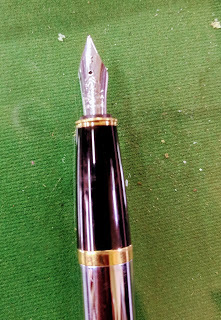
When I was young, from about age 10, we had to use fountain pens in school. That began a love affair with fountains pens, it is still something I cannot resist buying. My prized possession is the pen that belonged to my father. It was a Parker and he wrote his Matriculation examination with it. When I was going to sit for my Madhyamiks (as the Class X board exams of the West Bengal board is called), he gave it to me. I was over the moon with delight. Then one day, he took me to a quaint little shop just off Chowringhee. The Pen Hospital. I couldn’t believe that place existed. Not only did it fix all broken or damaged pens, they had am amazing collection for sale too! Nearby was another shop called Latif’s that fixed cameras. The last time I visited Latif’s he was telling me how business was bad what with digital cameras and big brands and shops taking over the market. Same with the pen hospital, they were saying collectors were few, this was a new world of use and throw! True that, my daughters never had to write with fountain pens in school, it was gel pens that they used, use and throw alright! Before I sat to write this, I looked online to see if either shop still exists! I’m please to say that they do!
Published on April 18, 2019 04:30
April 16, 2019
O: OLD-WORLD CHARM #AtoZChallenge
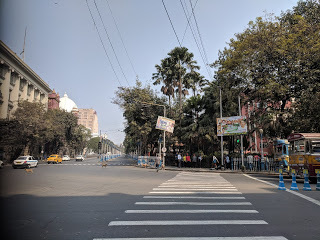
Whether you talk about Calcutta’s famous dhunuchi dance during the pujas or the old pujas in North Calcutta houses being performed over the years, whether you talk about visiting the old temples of Kalighat or Dhakhineswar, or whether it is the St James Church or the St Paul’s Cathedral, or whether you are visiting Astor Hotel housed in a hundred year old building or enjoying a drink at the Grand Hotel, this is a city where the new lives hand in hand with the old. The No 42 on Chowringhee which is now the tallest building in India (at about 268 meters) stands proud over the Maidan and has changed the skyline of Calcutta, peacefully co-exists with the older buildings around it. Come to Calcutta, feel the old-world charm of the city seep into your veins, this is a city that grows on you. And keeps you hooked! That is image is of the busy south western side of busy Dalhousie Square on a Sunday morning. That dome you see is the GPO, earlier part of the old Fort William. That was approximately where that infamous Black Hole tragedy purportedly occurred!
Published on April 16, 2019 23:08
April 15, 2019
N: New Market #AtoZChallenge
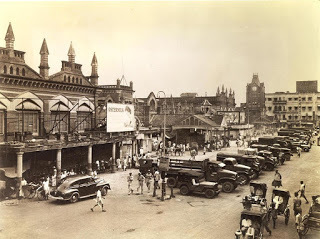
Image credit: By Clyde Waddell - http://www.library.upenn.edu/collecti..., Public Domain, https://commons.wikimedia.org/w/index...
Long long before there were fancy Air conditioned Malls and markets, Calcutta had it's very own "mall", in Lindsay Street, in the shape of New Market. They tried to name it Hogg Market after Sir Stuart Hogg the then Chairman of the Calcutta Corporation who contributed to its creation in a large was, but the name New Market just stuck. Initially opened to the public in 1874, primarily as a shopping centre for the British in Calcutta (yes, natives were not allowed to shop there!) it is now an iconic part of this old city. No matter what, despite the bustling Spencers and Big Bazars, I find myself returning, again and again, whether for the masala sausages or the ham or bacon or the Kalimpong Cheese or the delicacies from Nahoum! They say you can get anything here, you only have to know where to look!
As children we visited new market often enough. The best movie halls were also in the vicinity. I remember our excitement when denims first came to Calcutta. It was this brand called Avis, and their one shop was right below the famous clock tower which was brought over from Huddersfield in the 1930s. We got our new jeans and ate rolls from Nizam's (another land mark hotel nearby!) and ice cream and were happy.
Simple pleasures!
Published on April 15, 2019 22:32
M: Murari Pukur #AtoZChallenge

If you head eastwards down Vivekananda Road, you will pass Maniktola and reach a canal. Cross the canal and take a left. Another two hundred yards or so later, there is a narrow lane going in. Follow that winding road, to your right there will be a gate. Enter. The house is gone now, but the garden remains. And the pond. That is where my heart resides.
When they were breaking down the house, the masons refused to work, they said it was haunted. Each time they tried to remove a brick, someone sighed, asked them to stop. I trust it was my father's soul. When I heard, I went and got a brick back. They were able to break the house, thereafter, no ghosts. Irony.
I never wanted to sell the place, I still would hold on to it if I could. But life is not always ideal.
At the time that the house was built, Maniktola wasn't there. It was all jungle and grass. My ancestors built their garden house there. And what a gorgeous house it was. There was another one across the pond, for the ladies! My dad inherited it and there are countless memories of that house and those gardens. I know I have written about it often. We sometimes cribbed when we had to go, but now that I would not crib, there is no place to go.
Irony.
My Calcutta would never be complete without Murari Pukur, the land that I have lost.
Published on April 15, 2019 06:30
April 12, 2019
L: Lower Circular Road Cemetary #AtoZChallenge
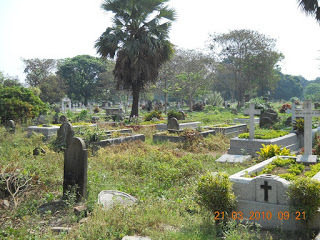 Image courtesy: lower-circular-road-cemetery
Image courtesy: lower-circular-road-cemeteryWhen anyone talks about cemeteries in Calcutta, they tell you to visit the South Park Street Cemetery, famous for supposed ghosts and what not. But when I talk about a cemetery, I am talking about the Lower Circular Road Cemetery, also known as General Episcopal Cemetery. It’slocated on the crossing of Park Street and Lower Circular Road and houses some of my ancestors. The Lower Circular Road Cemetery was established on 1840 and is still operating as a functional cemetery. It contains approximately 12,000 graves including many former British East India Company employees, among others. My mother, you, see, was Christian. I actually sometimes think that a cemetery is so much nicer than a cremation, you have a place you can visit where maybe something still remains of the person you love. The Lower Circular Road cemetery was close to where I lived while growing up. (So was the South Park Street one but that did not have that feel to it, you know what I mean?) That cemetery was on my list of walks, growing up. Not for the ancestors, not for the ghosts, but just because it was a pretty place to be in! My mother sometimes asked why I went there, was I just morbid? I don’t know, but I used to claim that Michael Madhusudan Dutt’s grave kept calling to me! Go figure!
Published on April 12, 2019 22:28
April 11, 2019
K: Kumartuli #AtoZChallenge
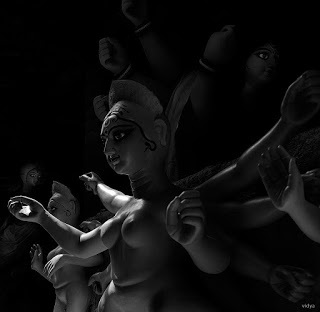
Image courtesy Vidya Chandy on one of our excursions in North Calcutta!
Kumartuli is a traditional potters’ quarter in north Calcutta located between Chitpur Road (now Rabindra Sarani) and the Hooghly River. Calcutta is famous as a sculpting hot-spot which not only manufactures clay idols for various festivals but also regularly exports them.As I explained earlier, when the East India Company decided to build a new settlement (Fort William) at the site of the Gobindapur village, most of the existing population shifted to Sutanuti. While neighbourhoods such as Jorasanko and Pathuriaghata became the centres of the local rich, there were other areas that were developed simultaneously and the villages of Gobindapur, Sutanuti and Kalikatadeveloped to give rise to the latter day metropolis of CalcuttaUnder orders from British East India Company, separate districts were given to the Company’s ‘workmen.’ These neighbourhoods in the heart of the Indian quarters (yes, Black town) acquired the work-related names – Suriparah (the place of wine sellers), Colootollah (the place of oil men), Chuttarparah (the place of carpenters), Ahiritollah (cowherd's quarters), Coomartolly /Kumartuli (potters’ quarters) and so on. Most of the artisans living in the north Calcutta neighbourhoods dwindled in numbers or even vanished, as they were pushed out of the area in the late nineteenth century by the “invasion” from the direction of Burrabazar as the city expanded. In addition, Marwari businessmen virtually flushed out many families from north Calcutta. The potters of Kumartuli, who fashioned the clay from the river beside their home into pots somehow managed to survive in the area. Gradually they took to making the images of gods and goddesses, worshipped in large numbers in the mansions all around and later at community pujas in the city and beyond. I do not like to take my car when I visit Kumartuli, usually with out of town friends/relatives. We take a cab or the Metro to Shobhabazar and walk to the artisan’s area through the narrow lanes which can take you back in time. Kumartuli is a visual delight. It is even more interesting if you can make it in the weeks leading up to Durga Puja but even otherwise, one can find idols being made. As they say in Bengal, in 12 months there are at least 13 pujas. In any case, it is always interesting to see how the idols are made and then painted so delicately and beautifully be the craftsmen. It is indeed a novel experience and one of the reasons why Calcutta remains unique. Once we are done with exploring the lanes and the tiny huts that house the families as well at the huge clay models, we have a tea (or two) in a clay pot and then take the narrow lanes twisting and turning and (maybe hop on to a tram or rickshaw if it’s too hot or you do not feel like walking) go through the labyrinthine lanes to Burrabazar and down Chitpur road for a well deserved lunch of Biriyani at Royal! Sometimes we even land up at the riverside at Jagannath Ghat, having headed westwards in our ramblings… and I don’t get bored with this ‘tour’. We just turn a different corner and come up with something new!
Published on April 11, 2019 23:47
April 10, 2019
J: Jorasanko #AtoZChallenge
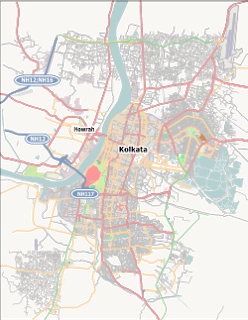
Jorasanko is a neighbourhood of north Kolkata so called because of the two (jora) wooden or bamboo bridges (sanko) that spanned a small stream at this point.It is famous for the Jorasanko Thakur Bari which is the ancestral home of Rabindranath Tagore (Thakur in Bengali) who needs no introduction, but apart from that, it was also home to Kaliprasanna Singha (author, playwright, and philanthropist), Krishnadas Pal (Indian journalist, orator and the editor of the Hindoo Patriot ) and others and can be termed as the cradle of the Bengal Renaissance. This area was earlier known as Mechua Bazar.
In school, we were made to study ‘Shahaj Path” when we started reading and writing Bengali. Although 'Shahaj Path' means 'Easy Reading",, to me at least, it was anything but. And yes, it was written by Rabindranath Tagore. While growing up I was never a big fan of Tagore’s works. Liking Tagore was too clichéd and common (if you know what I mean) and I did not understand a lot of it. The rebel in me just could not accept that I enjoyed reading his poems, specially the historical ones in "Kotha O Kahini". The fact that we ended up reading a lot of Tagore’s works in school was another sure shot way to ensure we never would want to read it ourselves. BUT. (There’s always a but). My father used to quote from Tagore. He had a few favourite lines and even now whenever I hear those lines, no matter what the context, his face floats in front of me, accompanied by a smile that I would kill to see again. He laughingly used to say that whenever you are at a loss of words, look up Tagore’s works, he will have said something! I started reading Tagore’s poems after my father died, really. I memorised lines that struck a chord and discovered for myself that indeed Rabindranath Tagore has something or the other to say about practically everything! My father also used to tease me that someday I would fall in love with a Bengali man and the love sonnets would come handy. Well. I did fall in love with a Bengali but his knowledge of sonnets were (thankfully) as wanting as mine! I leave you with a few lines of poetry, which still whispers to me in my father’s voice, in my ears:
“Aji hote shoto botshor poreyKe tumi poricho amar ei kobita khaniKoutuhol bhore,Aji hote shoto botshor porey.”
The poem goes on for some more lines. Loosely translated, (by Tagore himself), it means:
“Who are you, reader, reading my poems a hundred years hence?
I cannot send you one single flower from this wealth of the spring,
or one single streak of gold from yonder clouds.
Open your doors and look abroad.
From your blossoming garden gather fragrant memories of the
vanished flowers of an hundred years before.
In the joy of your heart may you feel the living joy that sang one spring morning, sending its glad voice across an hundred years..”
Published on April 10, 2019 21:15
April 9, 2019
I: Indian Museum #AtoZChallenge
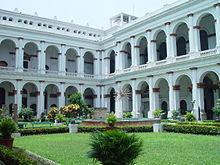 Image Credit:Indian_Museum,_Kolkata
Image Credit:Indian_Museum,_KolkataCalcutta is an old city, boasting of a lot of ‘oldest’s and ‘first’s. The Indian Museum(also referred to as the Imperial Museum in the texts of the British-India era) is one such. It is the largest and oldest museum in India and houses rare collections of antiques, armour and ornaments, fossils, skeletons, mummies, and Mughal paintings. It was founded by the Asiatic Society of Bengal in Calcutta in 1814. The founder curator was Nathaniel Wallich, a Danish botanist. History tells us that the the concept of having a museum arose in 1796 by members of the Asiatic Society as a place where man-made and natural objects could be collected, cared for and displayed. The objective began to look achievable in 1808 when the Society was offered suitable accommodation by the Government of India in the Chowringhee-Park Street area where it still stands. Today there are many galleries and exhibits, among them, the Egyptian collection, the Indian artefacts (which include a Buddhist stupa, the ashes of the Buddha, the Ashoka pillar etc) are notable. Also, there are four galleries dedicated to natural history. Now I am not a museum person. I do not enjoy museums, no matter where in the world it is and generally avoid them, barring a few where I take my children while on vacation. It’s hardly surprising that I have not visited the Indian museum in a while (translated, 30+ years!) but I have heard that it has been nicely restored and attracts visitors from all over the globe. We used to be forced to visit the museum in our school days, usually at an age when we were unable to appreciate either the history or the significance of the displays. I recall running about the halls, getting thoroughly bored and getting yelled at by the teachers! One year apparently our section was so naughty that the school decided we should be punished. So while all the other sections went to the zoo and the Botanical gardens and stuff, we were taken only to the Planetarium. And that was even more boring than the museum. We used to take off our shoes and socks and promptly fall asleep!
Published on April 09, 2019 23:52
H: Horticultural Gardens #AtoZChallenge
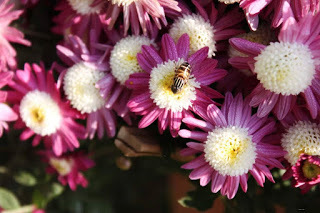 Picture credit: Nandini Sett nandinisett@gmail.com
Picture credit: Nandini Sett nandinisett@gmail.comThe Horticultural Garden of Kolkata is a famous green space, owned by the Agri-Horticultural Society of India. Covering 21 acres of land in Alipore, this garden is known for its fabulous collection of trees, flowering plants and other varieties of vegetation. It has an impressive infrastructure and is one of the most well-maintained gardens across the country.
There is a sprawling and well-manicured field in the garden, a greenhouse, a fruit orchard orchard, rose garden and even a garden for different varieties of xerophytes and orchids! One of the winter attractions in Calcutta is the annual flower show hosted at the Horticultural gardens.
The Agri Horticultural Garden includes a research laboratory, library and training centre, which facilitate horticulture studies. Nurseries and a florist shop are also present within this garden's complex, from where visitors can buy plant saplings and flower bouquets.As children , we visited the horticultural gardens often. My father was an avid gardener and he often went to but saplings, seeds, fertilizers and what not.
I did not inherit those genes. At one point of time Baba had these bid cemented pots built on the terrace. Each was rectangular in shape and approximately three feet by one feet and two feet in depth. He filled them with soil and told my sister and me that we had one each where we were to grow whatever we wanted. Excited, we accompanied him to the horticultural garden and got our seeds and stuff. We planted them. Within a week I was bored out of my wits. I dug up the my plot, built what were meant to be mud huts and generally mucked about. My sister's plot however was beautifully kept. She grew cucumbers and radish and lemons and things like that while I just made tea out of mud and water.
It's always been that way. My sister still loves her plants and has a good collection of them in her little verandah. She is happy when he lilies bloom. I do not share her excitement. She also regularly visits the annual flower show at the horticultural gardens. The picture above is one taken by her at the 2018 show. Me? I don't have a green bone in my body. I tried tending to a cactus while in college. It died on me.
Published on April 09, 2019 01:23
April 8, 2019
G: Ghosts of Calcutta High Court #AtoZChallenge
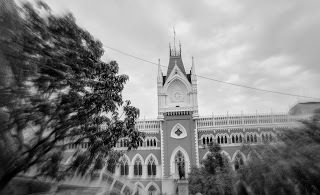
I've always been fascinated by ghosts and ghost stories. Calcutta abounds with such stories. And the High Court building in Calcutta is as good a place as any to catch these elusive spirits! The High Court at Calcutta was established in 1862 and is India’s oldest Court building. Construction of this beautiful neo-Gothic building (based on the Cloth Hall, Ypres in Belgium) was completed in 1872, ten years after the High Court was established. All kinds of cases, including criminal trials were heard and adjudicated here. It is an old heritage building and as with most historical buildings, the High Court building is considered by many to be one of the most haunted places in the city, with rumours floating around that some corridors are avoided even during the afternoon! While looking up ghost stories of the time I find that apparently there was a newspaper article in the 1980s which talked about how bloody footprints appeared from nowhere on the second-floor stairwell and abruptly disappeared into one of the courtrooms, with no signs of them thereafter. There is this other story of how a British judge spotted his wife while working late into the night while she was supposed to be in England. Soon a telegram arrived to announce the fact that she had died at the time of her appearance. There are court employees, lawyers, visitors and night guards who have, over the years, claimed to have seen a lady moving around the corridor. Is it the ghost of the British lady, or the relative of someone who was hanged to death in the Court premises? They say if you listen carefully, late in the evening one can hear the rattle of chains of criminals or the cries of others who wander these halls, still searching for justice. In all my years in the High Court I have had occasion to stay back till pretty late. Once after a long winded arbitration, I was walking down from the second floor library where we used to sit. I was alone. The Court building was deserted and empty. The lights were low. After Court hours certain gates are locked so I had to take a circuitous route to find a gate that was still open. As I walked down that long arched corridor between court room no 8 and court room no 1, I thought I heard footsteps behind me. I stopped, hoping it was someone I knew so we could walk together. But the footsteps stopped too, the gloomy corridor was empty. I continues walking and heard those footsteps again. As I reached the staircase to the ground floor, the footsteps faded. I walked a little fast .. faster than necessary to the waiting car.
A prankster, or a ghost? Truth? Or fiction? I’m not telling but there are now walks in Calcutta that take you through historic and old buildings at night, including the Calcutta High Court, in the hope of spotting some of the ghosts of Calcutta (trust me, there are many!)
Coming?
Published on April 08, 2019 04:28



